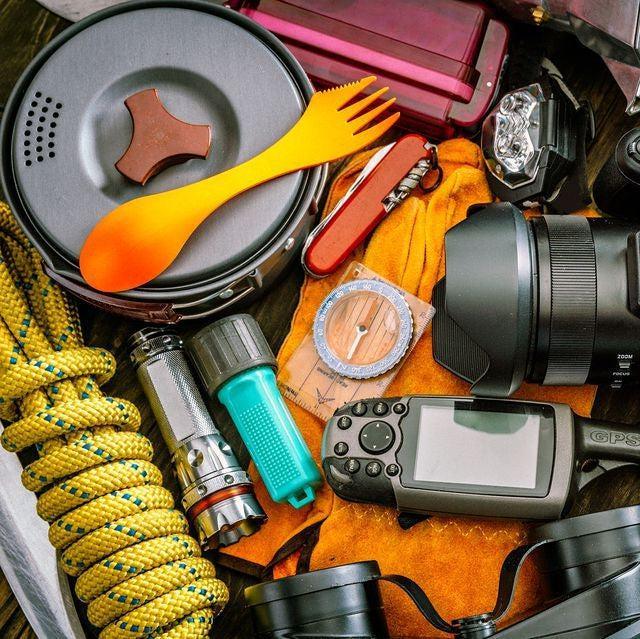
Emergency Shelters When You Are On The Move
Share
Surviving is all about prioritizing your needs. There are a lot of things you need to stay alive and healthy, but you don’t need them all right now. Some things can wait a while, but others are more urgent. Ask any survival expert for the top priority and they’re going to say “emergency shelter”. Yes, you can only survive three days without water – but if you’re caught without shelter in a blizzard, or even a late fall night in the average northern forest, and you’re not going to have to worry about three days from now. Because you’re not going to be around by dawn.
Shelter always features in a prepper’s plans, whether it’s a bugout (or bugin) location, or the tent you’ll be carrying on your way to one. Life doesn’t always go to plan though. What happens if you’re away from home when a crisis hits, and have to get back there without the gear you’d expected to have? What if you’re hunting or foraging in the woods, but get lost or injured and find yourself facing a night in the open?
There are many scenarios that could see you having to improvise a shelter, so knowing how to do it is a key survival skill. In fact, if you don’t know this one the rest aren’t going to help you much.
What Kind of Emergency Shelters Should You Make?
There are a few basic shelter designs; the right one for you will depend on the environment you’re in, the weather and the materials you have to work with. They all have their advantages and disadvantages, so it’s best to know how to make them all. Here are the main emergency shelter types:
Lean To
The lean to is the simplest kind of shelter, and also one of the most versatile. It can be made from almost any materials and is easy to build in most locations. Basically, a lean to is a shelter made from a single roof panel, raised at one end and meeting the ground at the other.
When putting up a lean to, aim to have the open end downwind. That way the wind will be hitting the edge that’s in contact with the ground, and deflecting up and over the shelter. You’ll be protected from wind chill, and there will also be a bubble of relatively still air just outside the shelter. Put a fire there and it will be protected too – and its heat will be able to get in the open end of the shelter, while smoke stays outside. Build a reflector of wet logs behind the fire to get the maximum benefit from its heat.
If there’s a fence, wall or fallen tree handy it can be used to hold up the raised end of your lean-to (although this might stop you putting a fire downwind). Alternatively, you can support that end with two upright posts and, if you’re building the shelter from natural materials, a crossbar.

A Frame/Tent Shape
Shelters can be built in the shape of a classic tent. This is a bit more complicated than a lean to, but it gives better protection from the elements because it’s in contact with the ground on two sides. That does a better job of keeping warm air in and the wind and rain out. For maximum protection close off one end of the shelter, leaving one open as a door. Set up tent-style shelters with the door downwind; again, you can put a reflector fire here for extra warmth.

In the woods, a tent-style shelter can be supported by a line or pole between two trees. In more open ground either a single pole or an A-frame of two poles lashed together will work fine. If you’re roofing it with natural materials add a ridge pole between the uprights; look for the straightest branch or sapling you can find.
Flat Shelter
Anyone who’s been in the Army has probably spent some time under a shelter half with its corners bungeed to four trees. This is a simple but useful shelter, especially if you’re worried about rain or frost, but not wind. One of the most useful things about it is that you can set it up at any height – 18 inches off the ground if you want to sleep under it, or eight feet up to give you and your buddies a place to stand out of the rain. If you’re using a tarp or groundsheet, a flat shelter will give you the maximum protected space underneath it.

Of course, flat shelters do have disadvantages. They’re open all round, so there’s no protection from the wind. Water also tends to collect on top, and eventually its weight can bring the whole thing down. Add a slight slope if you can, and if you’re using a tarp get it stretched out as tight and flat as possible.
Related: 3 Quick Shelters (The Last One is Invisible!)
What Materials Can You Use to Make Your Emergency Shelter?
Unless you’re actually in the desert you can build a shelter pretty much anywhere; you just need to know how to use the materials at hand. Luckily there’s a variety of things you can make a shelter from.
Waterproof Sheets
If you’re carrying a tarp, groundsheet, shelter half or even a rain cape, you’re going to have no trouble building a shelter. These make the most waterproof roofs you can get, and they’re also very light; that means the structure of the shelter can be simpler. For example, you can make a tent-style shelter with no ridgepole; the tarp needs, at most, a length of 550 cord to support it.
Best of all, building a shelter with a waterproof sheet is fast and easy. If the weather’s gone bad in a hurry and you’re caught in it, every minute counts; minimize lost body heat and soaked gear by being able to build a shelter in five minutes rather than a couple of hours.
Scavenged Plastic
We’re a throwaway society these days, and usually that sucks. Sometimes you can be grateful for it, though. Even in rural areas there’s usually plenty plastic sheet lying around in the form of garbage. Old feed and fertilizer sacks, trash bags, even plastic bags from the grocery store – collect enough of them and they can be fixed to a lightweight frame to make a pretty watertight roof. Make the frame by lashing or weaving thin, straight branches together in a grid; plastic can then be tied to the bars of the grid. Start adding plastic from the bottom and overlap the layers, so water can’t penetrate between pieces.
Leaves
If you’ve stood under a tree in the rain you’ll know that leaves are pretty good at keeping the water off. They’ll do a good job on your shelter, too. Just don’t try tying individual leaves to the frame; you’ll be there forever.

Instead, collect leafy branches. Again, start at the bottom and overlap layers. You’ll probably have to double up, as well; otherwise there will be gaps between leaves that rain and wind can get through.
Grass
Long grass is even more effective that leaves, if you get enough on your shelter and fasten it the right way. In fact, thatched roofs – layered bundles of grass or reeds – were used on houses for centuries, and there are still plenty of them keeping homes warm and dry in England and other countries. Cut long grass and make it into bunches, tie them at the cut end, then fasten them to your shelter frame with the cut ends up. Again, start at the bottom and overlap; the rain will run down the stalks rather than finding its way through, and it’ll all end up on the ground instead of on you.
Snow

Being caught without shelter in a blizzard is one of the worst things that can happen to you – but, if you know what you’re doing, the blizzard itself will give you the materials you need to survive it. Don’t waste time trying to build an igloo, though. That’s a highly skilled job, and unless you’re an eskimo you probably don’t have the skills.
Instead, just look for a deep snowdrift and burrow into one end of it. Excavate a tunnel, then a small cave long and wide enough to lie down in – just remember that the bigger you make it, the more of your body heat will go to heating it up.
Smooth down the inside to reduce drips as snow melts, and push a stick through the roof; give that a wiggle occasionally, to keep an airhole open. You should also check the access tunnel to make sure drifting snow isn’t sealing it off. It’s easy to asphyxiate in a snow cave if you don’t keep some ventilation going. You can pack the excavated snow into rough blocks, then stack them into a wall to keep snow out of the tunnel.
If you’re in the open and there aren’t any drifts handy, resurrect your childhood snowman-making skills. Make a big snowball, then roll it along the ground until it’s as big as you can push. Make three or four more and push them all together. Pack snow into any gaps, then tunnel into the middle of the pile.
Pick the Right Neighborhood
Lastly, don’t forget to find a good site for your shelter. Spending an extra two minutes looking for the right location can make all the difference. Here are some things to look for:
- Even the best improvised shelter can take a beating in a high wind. Walls, rocks or folds in the ground can all take the worst out of the wind before it gets to you.
- Save your roof some work, and pitch your shelter under a tree canopy. Some rain will get through the leaves, but a lot less than you’d get out in the open – and it won’t be traveling as fast, either, so the water pressure will be lower. Trees tend to shed water outwards, so if you’re inside the perimeter of its canopy you’ll be protected. Just avoid old or dead trees in a high wind.
- Dips and hollows. These often look like great places to shelter. They’re not. Cold air sinks, so on a cold night being in a 15-foot-deep hollow can translate into an air temperature 5°F lower. Dips and hollows are bad in the rain, too – the bottom is likely to get soaked. If it’s a gulley you could even get caught in a flash flood. Don’t look for the high ground, but avoid the lowest spots too.



1 comment
A tent provides a comfortable and affordable way to camp and experience nature without sacrificing your sleeping and living arrangements check on TentrentalsLongisland.